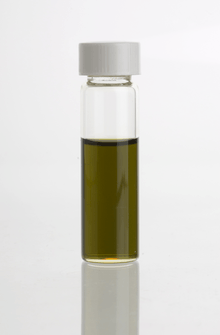Bergamot orange
| Bergamot orange Citrus bergamia | |
|---|---|
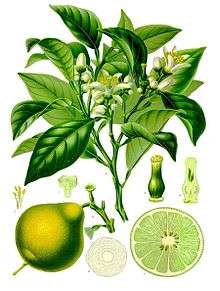 | |
| Scientific classification | |
| Kingdom: | Plantae |
| (unranked): | Angiosperms |
| (unranked): | Eudicots |
| (unranked): | Rosids |
| Order: | Sapindales |
| Family: | Rutaceae |
| Genus: | Citrus |
| Species: | Citrus bergamia |
| Binomial name | |
| Citrus bergamia | |
| Synonyms[2] | |
| |
Citrus bergamia, the bergamot orange (pronounced /ˈbɜːrɡəˌmɒt/), is a fragrant citrus fruit the size of an orange, with a yellow or green color similar to a lime, depending on ripeness.
Genetic research into the ancestral origins of extant citrus cultivars found bergamot orange to be a probable hybrid of lemon and bitter orange.[3] Extracts have been used to scent food, perfumes, and cosmetics.[4] Use on the skin can increase photosensitivity, resulting in greater damage from sun exposure.[5]
Etymology
The word bergamot is etymologically derived from the Italian word "bergamotto",[6] ultimately of Turkish origin: bey armudu or bey armut ("prince's pear" or "prince of pears").[7]
Description
Citrus bergamia is a small tree that blossoms during the winter. The juice tastes less sour than lemon, but more bitter than grapefruit.
Chemistry
The active ingredients in bergamot juice are neoeriocitrin, naringin, neohesperidin, ponceritin, melitidin, and mitrocin and 0.69% miriflin with 0% moisture brutieridin.[8] Melitidin and brutieridin, only recently discovered, exist only in citrus bergamot and exhibit statin-like properties.[9] Synephrine is not present in citrus bergamot.
Taxonomy
The bergamot orange is unrelated to the herbs known as bergamot or wild bergamot, Monarda didyma and Monarda fistulosa, which are in the mint family, and are named for their similar aroma.
Citrus bergamia has also been classified as Citrus aurantium subsp. bergamia (i.e. a subspecies of bitter orange).[10]
Citrus bergamia is sometimes confused with (but is not the same as):
- Citrus medica – citron, the yellow fruit of which is also known as etrog; or
- Citrus limetta, the "sweet lemon" or "sweet lime".
Production
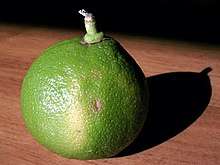
Production is mostly limited to the Ionian Sea coastal areas of the province of Reggio di Calabria in Italy, to such an extent that it is a symbol of the entire city. Most of the bergamot comes from a short stretch of land there, where the temperature is favourable. The fruit is also produced in Argentina, Brazil, Algeria, the Ivory Coast, Morocco, Tunisia, Turkey, and South-East Asia where it has its roots.
Citrus bergamot is commercially grown in southern Calabria (province of Reggio), southern Italy. It is also grown in southern France[11] and in Côte d'Ivoire for the essential oil and in Antalya in southern Turkey for its marmalade.[12] The fruit is not generally grown for juice consumption.[4] However, in Mauritius where it is grown on a small-scale basis, it is largely consumed as juice by the locals.
One hundred bergamot oranges yield about three ounces (85g) of bergamot oil.[13]
_-_Waddell%2C_Maricopa_County%2C_Arizona%2C_USA_-_January_2013.jpg)
Adulteration with cheaper products such as oil of rosewood and bergamot mint has been a problem for consumers. To protect the reputation of their produce, the Italian government introduced tight controls, including testing and certificates of purity. The Stazione Sperimentale per le Industrie delle Essenze e dei Derivati dagli Agrumi (Experimental Station for Essential Oil and Citrus By-Products) located in Reggio di Calabria, was the quality control body for the essential oil Bergamotto di Reggio Calabria DOP.[14] During World War II, Italy was unable to export to countries such as the Allied powers. Rival products from Brazil and Mexico came on to the market as a substitute, but these were produced from other citrus fruits such as sweet lime.[15]
Uses
Food and drink
The fruit of the bergamot orange is edible.
Tea and other uses
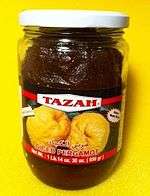
An essence extracted from the aromatic skin of this sour fruit is used to flavour Earl Grey and Lady Grey teas,[10] as well as confectionery (including Turkish delight [16]). It is often used to make marmalade, particularly in Italy. In Sweden and Norway, bergamot is a very common flavourant in snus, a smokeless tobacco product.[17] Likewise, in dry nasal snuff, it is also a common aroma in traditional blends.[18][19] Carpentierbe, a company based in San Giorgio Morgeto, makes a digestiv liqueur derived from bergamot marketed under the name Liquore al Bergamotto.
Fragrance
Bergamot peel is one of the most common ingredients used in perfumery,[20] prized for its ability to combine with an array of scents to form a bouquet of aromas which complement each other.[21] Bergamot is a major component of the original Eau de Cologne composed by Farina at the beginning of the 18th century in Germany. The first record of bergamot oil as a fragrance ingredient was in 1714, to be found in the Farina Archive in Cologne.
Bergamot essential oil is popular in aromatherapy.
Toxicology
In several patch test studies, application of some sources of bergamot oil directly to the skin of guinea pigs was shown to have a concentration-dependent phototoxic effect of increasing redness after exposure to ultraviolet light (due to the chemical bergapten, and possibly also citropten, bergamottin, geranial, and neral).[22][23] This is a property shared by many other citrus fruits. Bergapten has also been implicated as a potassium channel blocker; in one case study, a patient who consumed four litres of Earl Grey tea per day (which contains bergamot essential oil as a flavouring) suffered muscle cramps.[24]
Bergamot is also a source of bergamottin which, along with the chemically related compound 6',7'-dihydroxybergamottin, is believed to be responsible for grapefruit–drug interactions in which the consumption of the juice affects the metabolism of a variety of pharmaceutical drugs.[25]
Skin care
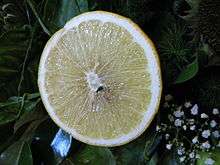
Bergamot is used in many skin care creams.
In the past, psoralen extracted from bergamot oil has been used in tanning accelerators and sunscreens. These substances have been known to be photocarcinogenic since 1959,[26] but they were only banned from sunscreens in 1995.[27] These photocarcinogenic substances were banned years after they had caused many cases of malignant melanoma and deaths.[28]
Medicinal properties
A highly concentrated extract of Bergamot has been shown to be a 'natural statin' that is beneficial in patients with dyslipidemia (an abnormal amount of lipids, such as triglycerides and cholesterol) in the blood. In a group of 107 patients with confirmed non-alcoholic fatty liver disease, the extract significantly improved all measured biochemical and ultrasonographic characteristics of the disease in 120 days without reported side effects.[29]
Other studies have shown that Bergamot juice reduces serum levels of lipids, attributable to its high content of neoeriocitrin, neohesperidin and naringin. A study of 80 subjects with moderate hypercholesterolemia (high cholesterol) found that a daily dose of a Bergamot extract significantly reduced plasma lipids and improved the lipoprotein profile. Subclinical atherosclerosis, which was assessed by carotid intima-media thickness, was also reduced significantly over a relatively short time frame of six months. Total cholesterol, triglycerides, and LDL-cholesterol were reduced, while HDL-cholesterol increased.[30]
Evidence is insufficient to indicate that bergamot oil is of medical benefit for some of its claimed uses.[5] Use on the skin can be unsafe, particularly for children and pregnant women.[5] Potential side effects of drinking large amounts of bergamot oil can include convulsions and death in children.[5]
The juice of the fruit has been used in Calabrian indigenous medicine in malaria.[31]
References
- ↑ The International Plant Names Index, retrieved 2 June 2015
- ↑ Porcher, Michel H.; et al. (1995), Multilingual Multiscript Plant Name Database (M.M.P.N.D): Sorting Citrus Names, The University of Melbourne
- ↑ Franck Curk, Frédérique Ollitrault, Andres Garcia-Lor, François Luro, Luis Navarro, Patrick Ollitrault; Phylogenetic origin of limes and lemons revealed by cytoplasmic and nuclear markers, Annals of Botany, Volume 117, Issue 4, 1 April 2016, Pages 565–583, https://doi.org/10.1093/aob/mcw005
- 1 2 Davidson, Alan. The Oxford Companion to Food (2006). Second Edition. Ed. Tom Jaine. p. 75. ISBN 0192806815.: "The bergamot orange is not edible and is grown only for its fragrant oil, although its peel is sometimes candied."
- 1 2 3 4 "BERGAMOT OIL: Uses, Side Effects, Interactions and Warnings". WebMD. Retrieved 2016-01-04.
- ↑ "Online Etymology Dictionary". etymonline.com.
- ↑ "Collins Dictionaries - Free Online". collinsdictionary.com.
- ↑ Cappello, AR, Dolce V, Iacopetta D, Martello M, Fiorillo M, Curcio R, Muto L, Dhanyalayam D. (2015). "Bergamot (Citrus bergamia Risso) Flavonoids and Their Potential Benefits in Human Hyperlipidemia and Atherosclerosis: an Overview". Mini-Reviews in Medicinal Chemistry. 16: 1–11. doi:10.2174/1389557515666150709110222. PMID 26156545.
- ↑ Di Donna, Leonardo; De Luca, Giuseppina; Mazzotti, Fabio; Napoli, Anna; Salerno, Raffaele; Taverna, Domenico; Sindona, Giovanni (2009). "Statin-like Principles of Bergamot Fruit: Isolation of 3-Hydroxymethylglutaryl Flavonoid Glycosides". Journal of Natural Products. 72 (7): 1352–1354. doi:10.1021/np900096w. PMID 19572741.
- 1 2 "Citrus bergamia". Germplasm Resources Information Network (GRIN). Agricultural Research Service (ARS), United States Department of Agriculture (USDA). Retrieved 2011-09-07.
- ↑ "Bergamot Orange - Citrus aurantium ssp bergamia". tradewindsfruit.com.
- ↑ Aktas, Ali (26 October 2004). "Reçellerin gözdesi, Bergamut(The most prominent marmalade: Bergamot)". ZAMAN. Retrieved 26 April 2012.
- ↑ Brannt, William Theodore; Schaedler, Karl. A Practical Treatise on Animal and Vegetable Fats and Oils
- ↑ "Decreto 15 novembre 2005 – Designazione della Stazione sperimentale per le industrie delle essenze e dei derivati degli agrumi quale autorità pubblica, incaricata di effettuare i controlli sulla denominazione di origine protetta "Bergamotto di Reggio Calabria", registrata in ambito Unione europea, ai sensi del regolamento (CEE) n. 2081/92" (PDF). ISMEA. Archived from the original (PDF) on 2012-04-25.
- ↑ Board, Niir (2011). "Oil of Bergamot." The Complete Technology Book of Essential Oils (Aromatic Chemicals). p. 75. ISBN 978-81-7833-066-2.
- ↑ Garbee, Jenn (2011, January 06). Three generations of Turkish delight in Southern California. Los Angeles Times.
- ↑ "Svensktsnus.se". general.se.
- ↑ Mohr, Melissa (17 November 2014). "How did we get from snuff to vaping?". OUP Blog. Retrieved 2 March 2016.
snuff could be colored and flavored in hundreds of combinations, including orange flower, rose, bergamot, musk, and tonka bean
- ↑ "FAQs". Wilsons & Co. (Sharrow) Ltd. Retrieved 2 March 2016.
The recipes known only to two members of the Wilson family in each generation since 1737, natural oils such as Bergamot, Attar of Roses, Jasmine and Sandalwood are added in precise measure to delight the nose.
- ↑ Zoe Diana Draelos (14 October 2015). Cosmetic Dermatology: Products and Procedures. Wiley. pp. 57–. ISBN 978-1-118-65546-7.
- ↑ Giovanni Dugo; Ivana Bonaccorsi (23 August 2013). Citrus bergamia: Bergamot and its Derivatives. CRC Press. pp. 467–. ISBN 978-1-4398-6229-2.
- ↑ Girard J, Unkovic J, Delahayes J, Lafille C (1979). "Phototoxicity of Bergamot oil. Comparison between humans and guinea pigs". Dermatologica (in French). 158 (4): 229–43. doi:10.1159/000250763. PMID 428611.
- ↑ Kejlova K, Jirova D, Bendova H, Kandarova H, Weidenhoffer Z, Kolarova H, Liebsch M (2007). "Phototoxicity of bergamot oil assessed by in vitro techniques in combination with human patch tests". Toxicology in Vitro. 21 (7): 1298–1303. doi:10.1016/j.tiv.2007.05.016. PMID 17669618.
- ↑ Finsterer, J (2002). "Earl Grey tea intoxication". Lancet. 359 (9316): 1484. doi:10.1016/S0140-6736(02)08436-2. PMID 11988248.
- ↑ Bailey, David G.; Malcolm, J.; Arnold, O.; Spence, J. David (1998). "Grapefruit juice–drug interactions". Br J Clin Pharmacol. 46 (2): 101–110. doi:10.1046/j.1365-2125.1998.00764.x. PMC 1873672. PMID 9723817.
- ↑ Urbach, F (1959). "Modification of ultraviolet carcinogenesis by photoactive agents". J Invest Dermatol. 32 (2, Part 2): 373–378. doi:10.1038/jid.1959.63. PMID 13641813.
- ↑ Autier P, Dore JF, Schifflers E, et al. (1995). "Melanoma and use of sunscreens: An EORTC case control study in Germany, Belgium and France". Int. J. Cancer. 61 (6): 749–755. doi:10.1002/ijc.2910610602. PMID 7790106.
- ↑ Autier, P.; Dore, J.-F.; Cesarini, J.-P.; Boyle, P. (1997). "Should subjects who used psoralen suntan activators be screened for melanoma?" (PDF). Annals of Oncology. 8 (5): 435–437. doi:10.1023/A:1008205513771. ISSN 0923-7534. PMID 9233521. Archived from the original (PDF) on November 27, 2014.
- ↑ "The Hepatic Effects of Citrus Bergamot Polyphenol Fraction (BPF) on Patients with Non-alcoholic Fatty Liver Disease and Metabolic Syndrome". Journal of Clinical Lipidology. Elsevier Inc. Retrieved 2017-11-20.
- ↑ Toth, PP; Patti, AM; Nikolic, D; Giglio, RV; Castellino, G; Biancucci, T; Geraci, F; David, S; Montalto, G; Rizvi, A; Rizzo, M (2015). "Bergamot Reduces Plasma Lipids, Atherogenic Small Dense LDL, and Subclinical Atherosclerosis in Subjects with Moderate Hypercholesterolemia: A 6 Months Prospective Study". Front Pharmacol. 6: 299. doi:10.3389/fphar.2015.00299. PMC 4702027. PMID 26779019.
- ↑ Krippner, Stanley; Ashwin Budden; Michael Bova; Roberto Galante (September 2004). "The Indigenous Healing Tradition in Calabria, Italy". Proceedings of the Annual Conference for the Study of Shamanism and Alternative Modes of Healing. San Francisco: Chair for Consciousness Studies at Saybrook Graduate School and Research Center. Retrieved 10 February 2009.
Bibliography
External links
| Wikimedia Commons has media related to Citrus bergamia. |
